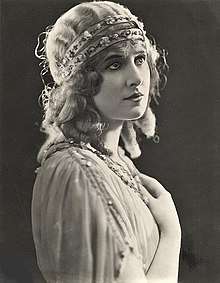Quo Vadis (1924 film)
| Quo Vadis | |
|---|---|
 Lillian Hall-Davis in Quo Vadis | |
| Directed by |
Gabriellino D'Annunzio Georg Jacoby |
| Produced by | Arturo Ambrosio |
| Written by |
Gabriellino D'Annunzio Georg Jacoby |
| Based on |
Quo Vadis by Henryk Sienkiewicz |
| Starring |
Emil Jannings Elena Sangro Lillian Hall-Davis Rina De Liguoro |
| Cinematography |
Curt Courant Alfredo Donelli Giovanni Vitrotti |
Production company | |
| Distributed by |
Unione Cinematografica Italiana (Italy) First National Pictures (US) |
Release date |
|
Running time |
90 minutes 120 minutes (director's cut) |
| Country | Italy |
| Language |
Silent Italian intertitles |
Quo Vadis (or Quo Vadis?) is a 1924 Italian silent historical film directed by Gabriellino D'Annunzio and Georg Jacoby and starring Emil Jannings, Elena Sangro and Lillian Hall-Davis. It is based on the novel Quo Vadis by Henryk Sienkiewicz which was notably later adapted into a 1951 film.
Plot
In Rome, during the reign of Nero, a young pagan general named Marcus Vinicius falls in love with a beautiful Christian hostage named Licia. Their love appears to be impossible, because of the conflict of their religions. Nero burns the city of Rome and blames the Christians, already hated by the pagan Romans.
Cast
- Emil Jannings as Nero
- Elena Sangro as Poppea
- Lillian Hall-Davis as Licia
- Rina De Liguoro as Eunica
- Andrea Habay as Petronius
- Raimondo Van Riel as Tigellinus
- Gildo Bocci as Vittelius
- Gino Viotti as Chilon Chilonides
- Alfons Fryland as Vinicius
- Bruto Castellani as Ursus
- Elga Brink as Domitilla
- Arnold Kent as Roman Guard
- Marcella Sabbatini as Girl
- Lucia Zanussi
Production
The film was produced by the ambitious Unione Cinematografica Italiana. D'Annunzio, the son of the poet Gabriele D'Annunzio, was considered a rising director and also wrote the film's screenplay. It was one of several attempts in early Fascist Italy to recapture the success of the historical epics of the previous decade.[1] Rudolph Valentino was invited to star in the film, but was forced to turn the offer down due to contractual reasons.[2] Production quickly became troubled – the film ran seriously over-budget, and additional financing had to be raised from Germany. The new backers insisted that a German director, Jacoby, be appointed to co-direct.[3]
Reception
The film was a critical and commercial failure on its release, effectively ending the career of its producer Arturo Ambrosio, who had been one of the major figures of early Italian cinema.[4] In its review The New York Times described it as "excellent as spectacle, but is too tedious in many sequences to be a good entertainment".[5] D'Annunzio never directed or wrote another film. Jacoby's reputation also suffered heavily, and he switched to working on musicals and comedies.[6] Emil Jannings' performance, on the other hand, received moderate praise. The New Yorker noted that Jannings was the "one item beside boredom"[7] the movie had, but despite his "able performance"[7] they "still prefer him in Germanic studio surroundings."[7]
References
Bibliography
- Barton, Ruth. Hedy Lamarr: The Most Beautiful Woman in Film. University Press of Kentucky, 2010.
- Holston, Kim R. Movie Roadshows: A History and Filmography of Reserved-Seat Limited Showings. McFarland, 2012.
- Moliterno, Gino. The A to Z of Italian Cinema. Scarecrow Press, 2009.
- Ricci, Steven. Cinema and Fascism: Italian Film and Society, 1922–1943. University of California Press, 2008.
- Scodel, Ruth & Bettenworth, Anja. Whither Quo Vadis: Sienkiewicz's Novel in Film and Television. John Wiley & Sons, 2009.
- Williams, Michael. Film Stardom, Myth and Classicism: The Rise of Hollywood's Gods. Palgrave Macmillan, 2012.
External links
- Quo Vadis on IMDb
- Quo Vadis at The GreatStars.com; Lost Films Wanted(Wayback Machine)(#note:the film survives)